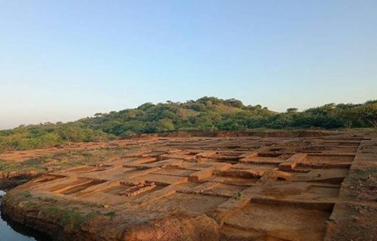

23rd May 2023 (7 Topics)
Context
- A shell bangle, pottery fragments, stone knives, and even human skeletal remains were discovered recently, in a 16-hectare stretch on the borders of Khatiya village in Gujarat’s Kutch district.
Key highlights:
- The 16-hectare burial site in Khatiya village in Gujarat is the largest pre-urban Harappan cemetery, with unexpected finds such as shell bangles, pottery shards, stones blades, and human skeletal remains.

Discovery of Harappan Graves:
- A multi-disciplinary international team of archeologists has discovered 500 graves and excavated 197 of them, but deep below.
- Led by Rajesh S V, Assistant Professor in the Department of Archaeology at the University of Kerala, the researchers are looking for clues to see if the cemetery, believed to be 5,000 years old, was a big human settlement or a common facility for a cluster of smaller settlements.
- The cemetery is believed to be 5,000 years old and belongs to the 'pre-urban' phase of the Harappan civilisation.
|
Harappan Civilisation
|
About: Khatiya village of Gujrat
- The soil in Khatiya is acidic, making it difficult to extract DNA from samples excavated.
- This could help answer the mystery of the people buried in these graves and where they came from.
- Khatiya is located on the banks of the Gandi, a stream that drains into the Great Rann of Kutch (GRK).
- Dhoro Chhelo: A pond was dug on the south-western periphery of the ancient burial site in 2016 as part of the government’s initiative to harvest the water of Dhoro Chhelo.
Recent theory about Dholavira:
- Dholavira is a UNESCO World Heritage Site and one of the biggest metropolises of the Harappan civilisation, but it is 150 kilometres away from Khatiya, making it unlikely that people in the urban settlements of Dholavira were buried there.
- Harappan sites in western Kutch: Desalpar and Khirsara, Kotda Bhadli and Nadapa are the other well-known Harappan sites in western Kutch.
- But each of them is a site of urban and post-urban periods of the Harappan civilisation and more than 50 km away from Khatiya.
- Being a pre-urban Harappan cemetery, there is a possibility that either there was a big settlement in Khatiya or there were smaller settlements around Khatiya and the cemetery was a common burial ground for them.
|
Team of Archaeologists: The international team of collaborators included 27 archaeologists, DNA analysts, geologists and GIS specialists from Gujarat, Maharashtra, Kerala, Spain, USA, Japan and Sweden. |


